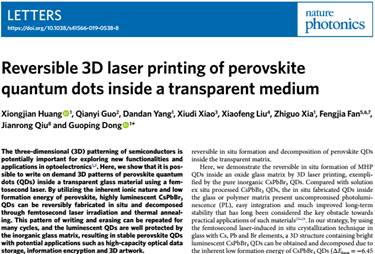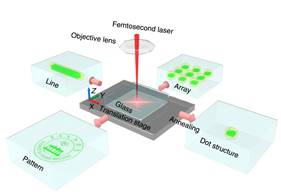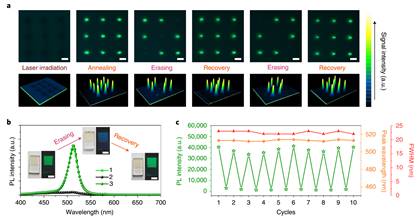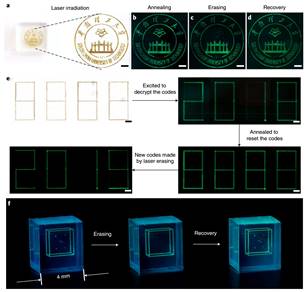The research group led by Prof. Guoping Dong at the State Key Laboratory of Luminescent Materials and Devices and Institute of Optical Communication Materials, School of Materials Science and Engineering, South China University of Technology, reported reversible 3D perovskite quantum dot patterns inside a glass by femtosecond laser irradiation and thermal treatment, entitled ‘Reversible 3D laser printing of perovskite quantum dots inside a transparent medium’, which was published in Nature Photonics (2020, 14(2): 82-88).

A research paper of Prof. Dong Guoping's group was published in Nature Photonics.
Metal halide perovskites (MHPs) have received considerable attention in optoelectronic devices due to their outstanding optical and electric properties. However, MHPs with unprotected surfaces usually suffer from poor stability while exposed to the outer environment due to their low formation energy. Therefore, it is urged to study the mechanism and develop strategies for MHPs to improve their stability or recover their performance after being destroyed.

Fig. 1 Schematic of the femtosecond laser writing system for sample fabrication.
The three-dimensional (3D) patterning of semiconductors is potentially important for exploring new functionalities and applications in optoelectronics. Prof. Dong’s group achieved the reversible in situ formation of perovskite quantum dots (QDs) inside a transparent glass matrix via femtosecond laser irradiation and thermal treatment. They utilized the localized heat from the focused femtosecond laser beam to initially form perovskite crystal seeds inside the glass matrix. And then the perovskite crystal seeds grow into QDs under thermal treatment. The stable inorganic glass matrix offers a robust protection layer for perovskite QDs against moisture and oxygen. Interestingly, the luminescence from perovskite QDs can be quenched by femtosecond laser-induced defects and damage of QDs, and importantly, recovered by thermal healing of QDs. By researching the mechanism, they found that it is the low formation energy and the soft ionic crystal structure of perovskites that enable the reversible formation of perovskite QDs.

Fig. 2. Reversible PL of perovskite QDs in the glass during the erasing and recovery process.
Patterning of MHPs into different nano- and microstructures can apply in high-performance optoelectronic applications with unique structures and specific functions. This group also demonstrated that 2D and 3D luminescent perovskite QD patterns can be directly and facially printed by the laser writing technique, which will potentially enable novel applications of perovskite materials in fields of optical data storage, 3D display, anti-counterfeiting, and information encryption.

Fig. 3 Applications of 2D and 3D patterns of perovskite QDs in information storage, information security, and 3D displays.
The research was also reported by News & Views of Nature Photonics, Science Foundation in China, and China Science Daily.
The first author is Huang Xiongjian, a Ph.D. candidate from SCUT. The corresponding author is Prof. Dong Guoping from SCUT. The co-authors of this paper are researchers from University of Science and Technology of China and Zhejiang University. The research work was supported by the National Key R&D Program of China, the National Natural Science Foundation of China, the Natural Science Foundation of Guangdong Province.
Corresponding link: https://www.nature.com/articles/s41566-019-0538-8





